Integrative Scenario Assessment as a Tool to Support Decisions in Energy Transition
Abstract
1. Introduction: Background and Rationale
2. Materials and Methods
2.1. Scenario Design and Selection
2.1.1. Context Scenarios and CIB
2.1.2. Scenario Selection (“Step 1”)
- Scenario descriptors with particularly high influence on the sustainability assessment, like demographic and GDP development, may dominate indicator performances and, thus, the assessment. In order to create a subset of scenarios suitable for the analysis of weaker impacts of other descriptors on the sustainability performance, we requested that both additional scenarios should include the same assumptions about demographic and GDP developments as the ‘Target’ scenario. This ensures that differing sustainability performances within this subset are caused by other scenario characteristics besides these two major factors.
- Within the remaining degrees of freedom, the “social sustainability” of the two scenarios, i.e., the performance of the non-model-based indicators published in [37], should be as different as possible, in order to allow for a sufficiently contrasting sustainability comparison, especially regarding these indicators.
2.2. Indicator Selection (“Step 2”)
- 16 indicators for which quantitative values could be calculated with the model used, the enhanced energy system model MESAP (see Section 2.3).
- 6 indicators addressing some key socio-technical issues in energy system transition processes, for which such model-based analyses were not possible, but performance trends for 2050 were estimated based on estimations of impacts of scenario descriptors on them (see Section 2.4).
- Non-Model-Based Indicators
- monthly energy expenditures (for electricity, heat) of lower-income households with a monthly net income less than €1300;
- federal expenditures for energy research;
- acceptance of renewable energies in the neighborhood;
- degree of internalization of energy-related external costs;
- share of households producing renewable electricity and
- number of energy cooperatives engaged in renewable energy plants.
- Model-Based Indicators (Incl. Acronyms in Energy System Model Terms)
- energy-related emissions of particulate matter (TSP emissions);
- energy-related emissions of cadmium (Cd emissions);
- energy import dependency (Import share);
- final energy consumption of private households per capita (FEC RES per cap);
- share of renewable energy in gross final consumption of energy (RES share in GFEC);
- area under cultivation of energy crops (Area crops);
- use of primary energy (PEC);
- specific final energy consumption of households for heating (temperature-corrected) (FEC for SH per floor area);
- final energy consumption in the transport sector (FEC transport);
- number of electric vehicles (No. electric vehicles);
- final energy productivity of the German economy (GDP per FEC);
- final energy productivity of the industry (GVA industry per FEC);
- final energy productivity of trade, commerce and services (GVA services per FEC);
- energy-related greenhouse gas emissions (GHG emissions);
- energy-related emissions of acid-forming gases (Acid forming gases emissions) and
- installed capacity of renewable energy power plants (RES capacity).
2.3. Scenario Modelling and Quantification of Model-Based Indicators (“Steps 3 and 4”)
2.4. Quantification of Non-Model-Based Indicators (“Step 5”)
- In the approach presented here, only direct impacts were considered, and no impacts conveyed indirectly via another descriptor, in order to avoid “double counting” and an according overvaluation of certain influences;
- every descriptor/indicator impact on the −3/+3 scale refers to changes against the present state of a descriptor or an indicator. For example, if the current (status-quo) value of the descriptor “Attitudes of the population towards the transformation of the energy system” is positive and the future value of this descriptor in a given scenario is also “positive” (i.e., no change occurs), then a “0” should be assigned to the indicator development.
2.5. Normalisation of the Indicator Results (“Step 7” and “Step 8”)
2.6. Methodical Basics of the Scenario Assessment Approach (“Step 9”)
3. Results
3.1. Strength-Weaknesses-Analysis for an Exemplary Scenario
3.1.1. Exemplary Results for Model-Based Indicators for the INERTIA Scenario
3.1.2. Exemplary Results for Non-Model-Based Indicators for the INERTIA Scenario
3.1.3. Integrative Scenario Performance Analysis
- Strengths
- TSP-emissions;
- Cd-emissions;
- FEC RES per cap;
- FEC SH/floor area and
- GVA services/FEC.
- Weaknesses
- Energy expenditures;
- internalization;
- number of cooperatives;
- import share; and
- area crops.
3.2. Comparison of Scenario Performance Based on Selected Indicators
3.2.1. General Observations
- Each scenario achieves goal compliance (performance ≥ 100%) for at least one indicator, and no scenario achieves goal compliance for all indicators. However, there are differences. Whereas INERTIA meets goals only for four indicators (TSP emissions, FEC RES per cap, FEC SH/floor area, and GVA services/FEC), VALUE CHANGE is successful in 17 out of 22 indicators.
- The role of a top performer (reaching at least 90% of the score of the best performing scenario) is taken;
- for 18 indicators by VALUE CHANGE;
- for 11 indicators by COPING WITH PRESSURE;
- for 9 indicators by TARGET; and
- for 3 indicators by INERTIA, MARKET, and TARGET CENTRALIZED.
- Negative indicator values (development running against target direction) are observed in four scenarios—only VALUE CHANGE and MARKET never do.
- All scenarios include weak points: Even VALUE CHANGE, the best global performer, shows a minimum performance of only 11% (indicator ‘Area crops’). Only two scenarios show positive performances for all indicators (VALUE CHANGE and MARKET, see above). All other scenarios include at least one indicator showing negative performance, implying developments leading in the wrong direction.
3.2.2. Identifying Pareto-Optimal Scenarios
3.2.3. Indicator Profile Archetypes
- Proposing a “Typification Project”
3.2.4. Discussion of the Indicator Profile Archetypes
- Discussion of Type I indicator results
- Discussion of Type II indicator results
- Discussion of Type III Indicator Results:
- Type IV analysis:
- strong expansion of renewables in the electricity sector (requiring a high level of research);
- transition towards decentralized electricity generation and storage (requiring a crucial change in the system architecture, which has to be prepared by research); and
- positive citizen’s attitude towards the energy transition (lowering the political hurdles for spending high amounts of tax money in energy research).
4. Discussion—Lessons Learned
- an approach to analyze and assess not only commonly applied techno-economic, model-based indicators, but also non-model-based social and socio-technical indicators previously missing in scenario assessment studies,
- the use of social context scenarios as a tool to suitably address social and socio-technical aspects in scenario design, and as a source of information to explain and justify assessments,
- an approach to standardize and cluster evaluation results in a compatible way, allowing for the comparability of different types of indicators, indicator values, and assessment procedures, and, thus, for systematic comparison of scenario performances.
- Step 1 (Scenario Selection):
- Step 2 (Indicator Selection):
- Steps 3 + 4: (Detailed Scenario Modelling and Quantification of Model-Based Indicators)
- Step 5 (Determining Future Values for Non-Model-Based Indicators):
- Step 6 (Identification of Goals for Model-Based Indicators):
- Step 7 (Determining Goals for Non-Model-Based Indicators):
- Step 8 (Standardization in the Distance-to-Target Procedure):
- Step 9 (Evaluation):
- With the focus on a differentiated strength-weakness analysis of scenarios, the approach differs from common MCDA methodologies, which aim at a ranking of alternatives. Such a ranking requires an explicit or implicit weighting of criteria or indicators, which, in the authors’ view, should not be carried out by scientific experts, but rather by political decision-makers and social groups. Therefore, with the method presented here, no scenario ranking is aimed at first, but providing a differentiated basis for a possible subsequent ranking process.
- There are several points to be noted regarding the possibility of a structured evaluation of indicator results, which goes beyond or complements a strength-weakness analysis based on individual indicators, as indicated in Section 3.2:
- An allocation of indicators to predefined archetypes, which refer to the structure of the indicator value distribution and the goal achievement of the indicators across the 6 selected scenarios, can be first of all meaningful in labor-economic terms. If complete typologies and valid analysis programs for each archetype are available, a larger number of indicators could be processed, compared, and discussed for more scenarios and a state-of-the-art how indicator performances of a scenario set should be compared can emerge.
- The consideration of such value and goal achievement profiles of indicators rather makes it possible to recognize structural similarities of results between indicators across all regarded scenarios, even if the different scenarios exhibit different distributions of indicator values in detail.
- The degree of goal achievement is the main reference point for the profile analysis of indicators. Thus, the profiles of indicators that have been worked out do not represent fundamental “characteristics” of indicators, but depend on the target values set for them. The type assignment of indicators can change if targets are defined differently. For example, in the case of more challenging target values, indicators that were assigned as “Nobrainer” in the described example could change into a different, worse performing archetypes. Changes could also occur with a different scenario selection regarding type or number. In general, the more scenarios are considered, the more robust the typification approach becomes.
- The orientation of target values for non-model-based indicators on the performance of all scenarios and the normalization based on this have consequences for a plausible interpretation of the archetype evaluation. Therefore, there is no information available about the good or bad performance of scenarios in absolute terms, but only “better-worse statements” are possible. For example, in a scenario set in which all scenarios perform more or less well with respect to an indicator, some scenarios would still be evaluated as relatively bad compared to the better ones. This compulsion, which is implicit in the normalization process to identify both relatively good and relatively bad scenarios, regardless of their absolute performance, also puts the interpretability of the archetypes into perspective: For example, no representative set of scenarios can then be composed only of scenarios that can be evaluated as very good in relation to an indicator, as it would correspond to archetype I (“Nobrainer”). Thus, for methodological reasons, this type can only make meaningful statements for model-based indicators with their externally set target values, whereas its occurrence with non-model-based indicators would only be an indication of a non-representative scenario selection.
5. Conclusions
- A selection of scenarios to be evaluated out of the total number of consistent scenarios, developed by a CIB analysis or comparable approaches, is at least required from a labor-economic point of view, if, as is usually the case, project resources are limited. Nevertheless, for the non-model-based indicators in the example outlined here, all consistent scenarios could be evaluated using suitable algorithms. Ideally, such an overall view should also be carried out for the model-based indicators. For this purpose, suitable procedures should have to be developed. Their concrete design, actual development and application will depend, on the one hand, on the number of context scenarios, the models used and the associated computational effort, as well as the effort required to translate information from the context scenarios into model logics; on the other hand, it will depend on the willingness to provide resources for this purpose, weighing up expected benefits in terms of better (more robust) evaluation results and required efforts.
- In addition, possibilities should be explored for which models it would be possible to integrate indicators into the model logics that have been non-model-based ones previously, and the cost-benefit-relation of such model enhancements should be examined.
- Against the background of the necessary efforts outlined for both model-based and non-model-based indicators, for reasons of analytical practicability as well as communicability of results to addressees, a reduction of the set of 45 indicators used here as a starting point should also be considered. Here, it is important not to lose relevant topics and to involve experts and stakeholders in potential prioritizations of indicators. One option to solve this challenge could be to determine a system of core indicators mandatory for any application case, and supplementary indicators that can be added on a case-by-case basis.
- In cases where a determination of clear and comprehensible absolute targets for model-based indicators is difficult or impossible, the procedure applied to the non-model-based indicators, i.e., referring to “qualitative” or relative targets based on frequency distributions of indicator values in all scenarios analyzed (step 7), could be an option to be considered as well. The key assessment criterion would then be the progress towards what is achievable within the scope of “future worlds” described in the set of scenarios.
- As an alternative to the percentile approach used to determine targets for the non-model-based indicators, an attempt could be made to translate the future indicator values classified on the +3/−3 scale into a scale with physical units (tons, Euros, etc.). This would allow for a direct measuring of the distances to targets expressed in these units. It would require a well-founded decision on the detailed methodological procedure, in any case additional expert knowledge (and thus additional resources), and at the same time raise new methodological questions.
- In addition, the choice of the normalization method for values of model-based and non-model-based indicators for comparability purposes could be discussed, with respect to alternative options to be tested and, in general, referring to how this decision depends on the particular question or objective of the analysis.
- Regarding the intention to classify scenario performances in a structured way, alternatives to the archetype-based typification applied here could be discussed and tested.
- A sustainability-related ranking of scenarios, which has not been carried out in the example described in this article for reasons mentioned above, could be envisaged as a complementary step to a strengths-weaknesses analysis. For this purpose, prioritizations of indicators would be necessary. This could be based on a CIB analysis, e.g., revealing indicators with most and strongest interdependencies to other indicators (and thus being most relevant), but also on stakeholder assessments or sensitivity analyses with different indicator prioritizations, in order to show the effects of varying indicator priorities on evaluation results.
- Another approach would be to conduct sensitivity analyses for different percentile variants, in order to reduce the need to justify the use of only one variant. In principle, such sensitivities would also have to be carried out for those model-based indicators for which no “official” target values exist and own proposals have been made.
- Beyond the results presented in this article, the robustness of analyses and results, being an important criterion for the quality of a methodology, could be analyzed in two respects:
- The number of descriptors influencing an indicator and the strength of influences is relevant for its influenceability and, thus, for recommendations to decision makers. With regard to the performance of an indicator, robustness increases the number of influencing factors, because the weight of the individual factor or its non-consideration decreases accordingly;
- from the perspective of an intervening actor, however, robustness in the sense of intervention effectiveness increases if the number of drivers influencing the indicator decreases.
Supplementary Materials
Author Contributions
Funding
Acknowledgments
Conflicts of Interest
References
- International Energy Agency. Energy and Climate Change: World Energy Outlook Special Report; International Energy Agency: Paris, France, 2015. [Google Scholar]
- Duscha, V.; Wachsmuth, J.; Eckstein, J.; Pfluger, B. GHG-Neutral EU2050—A Scenario of an EU with Net-Zero Greenhouse Gas Emissions and Its Implications; Climate Change Report 40/2019, German Environment Agency: Dessau-Rosslau, Germany, 2019. [Google Scholar]
- International Energy Agency. Energy and Air Pollution: World Energy Outlook Special Report; International Energy Agency: Paris, France, 2016; p. 1. Available online: https://webstore.iea.org/download/summary/343?fileName=English-WEO-Air-Pollution-ES.pdf (accessed on 10 December 2020).
- Savaget, P.; Geissdoerfer, M.; Kharrazi, A.; Evans, S. The theoretical foundations of sociotechnical systems change for sustainability: A systematic literature review. J. Clean. Prod. 2019, 206, 878–892. [Google Scholar] [CrossRef]
- Wiek, A.; Binder, C.; Scholz, R.W. Functions of scenarios in transition processes. Futures 2006, 38, 740–766. [Google Scholar] [CrossRef]
- Grunwald, A. Energy futures: Diversity and the need for assessment. Futures 2011, 43, 820–830. [Google Scholar] [CrossRef]
- Kosow, J.; Gaßner, R. Methods of Future and Scenario Analysis: Overview, Assessment and Selection Criteria; German Institute for Development Policy, Studies: Berlin, Germany, 2008. [Google Scholar]
- Hofman, P.; Elzen, B.; Geels, F. Sociotechnical scenarios as a new policy tool to explore system innovations: Co-evolution of technology and society in The Netherlands electricity domain. Innovation 2004, 6, 344–360. [Google Scholar] [CrossRef]
- Weimer-Jehle, W.; Buchgeister, J.; Hauser, W.; Kosow, H.; Naegler, T.; Poganietz, W.-R.; Pregger, T.; Prehofer, S.; Von Recklinghausen, A.; Schippl, J.; et al. Context scenarios and their usage for the construction of socio-technical energy scenarios. Energy 2016, 111, 956–970. [Google Scholar] [CrossRef]
- Weimer-Jehle, W.; Vögele, S.; Hauser, W.; Kosow, H.; Poganietz, W.-R.; Prehofer, S. Socio-technical energy scenarios: State-of-the-art and CIB-based approaches. Clim. Chang. 2020, 162, 1723–1741. [Google Scholar] [CrossRef]
- Pope, J.; Bond, A.; Hugé, J.; Morrison-Saunders, A. Reconceptualising sustainability assessment. Environ. Impact Assess. Rev. 2017, 62, 205–215. [Google Scholar] [CrossRef]
- Sala, S.; Ciuffo, B.; Nijkamp, P. A systemic framework for sustainability assessment. Ecol. Econ. 2015, 119, 314–325. [Google Scholar] [CrossRef]
- Dalal-Clayton, B.; Sadler, B. Sustainability Appraisal: A Sourcebook and Reference Guide to International Experience; Routledge: Oxfordshire, UK, 2014. [Google Scholar]
- Bond, A.; Morrison-Saunders, A.N.; Pope, J. Sustainability assessment: The state of the art. Impact Assess. Proj. Apprais. 2012, 30, 53–62. [Google Scholar] [CrossRef]
- Gasparatos, A.; Scolobig, A. Choosing the most appropriate sustainability assessment tool. Ecol. Econ. 2012, 80, 1–7. [Google Scholar] [CrossRef]
- Streimikiene, D. A Sustainability Assessment in the Energy Sector; Nova Science Publishers: New York, NY, USA, 2018. [Google Scholar]
- Burgherr, P.; Hirschberg, S. Sustainability Assessment for Energy Technologies. In Handbook of Clean Energy Systems; Chou, S., Wei, J., Yan, J., Eds.; Wiley: Hoboken, NJ, USA, 2015; Volume 6, p. 22. [Google Scholar]
- Santoyo-Castelazo, E.; Azapagic, A. Sustainability assessment of energy systems: Integrating environmental, economic and social aspects. J. Clean. Prod. 2014, 80, 119–138. [Google Scholar] [CrossRef]
- Forés, V.I.; Bovea, M.; Belis, V.P. A holistic review of applied methodologies for assessing and selecting the optimal technological alternative from a sustainability perspective. J. Clean. Prod. 2014, 70, 259–281. [Google Scholar] [CrossRef]
- Bohunovsky, L.; Jäger, J.; Omann, I. Participatory scenario development for integrated sustainability assessment. Reg. Environ. Chang. 2011, 11, 271–284. [Google Scholar] [CrossRef]
- Fauré, E.; Arushanyan, Y.; Ekener, E.; Miliutenko, S.; Finnveden, G. Methods for assessing future scenarios from a sustainability perspective. Eur. J. Futur. Res. 2017, 5. [Google Scholar] [CrossRef]
- Arushanyan, Y.; Ekener, E.; Moberg, Å. Sustainability assessment framework for scenarios—SAFS. Eviron. Impact Assess. Rev. 2017, 63, 23–34. [Google Scholar] [CrossRef]
- Junne, T.; Simon, S.; Buchgeister, J.; Saiger, M.; Baumann, M.; Haase, M.; Wulf, C.; Naegler, T. Environmental sustainability assessment of multi-sectoral energy transformation pathways: Methodological approach and case study for Germany. Sustainability 2020, 12, 8225. [Google Scholar] [CrossRef]
- Moslehi, S.; Reddy, T.A. A new quantitative life cycle sustainability assessment framework: Application to integrated energy systems. Appl. Energy 2019, 239, 482–493. [Google Scholar] [CrossRef]
- Onat, N.C.; Kucukvar, M.; Halog, A.; Cloutier, S. Systems thinking for life cycle sustainability assessment: A review of recent developments, applications, and future perspectives. Sustainability 2017, 9, 706. [Google Scholar] [CrossRef]
- Martín-Gamboa, M.; Iribarren, D.; García-Gusano, D.; Dufour, J. A review of life-cycle approaches coupled with data envelopment analysis within multi-criteria decision analysis for sustainability assessment of energy systems. J. Clean. Prod. 2017, 150, 164–174. [Google Scholar] [CrossRef]
- Jewell, J.; Cherp, A.; Riahi, K. Energy security under de-carbonization scenarios: An assessment framework and evaluation under different technology and policy choices. Energy Policy 2014, 65, 743–760. [Google Scholar] [CrossRef]
- Schwarz, J.; Witt, T.; Nieße, A.; Geldermann, J.; Lehnhoff, S.; Sonnenschein, M. Towards an Integrated Development and Sustainability Evaluation of Energy Scenarios Assisted by Automated Information Exchange. In Smart Cities, Green Technologies, and Intelligent Transport Systems; Donnellan, B., Klein, C., Helfert, M., Gusikhin, O., Pascoal, A., Eds.; Springer: Cham, Switzerland, 2019; pp. 3–26. [Google Scholar]
- Eichhorn, M.; Masurowski, F.; Becker, R.; Thrän, D. Wind energy expansion scenarios—A spatial sustainability assessment. Energy 2019, 180, 367–375. [Google Scholar] [CrossRef]
- Walker, S.; Labeodan, T.; Boxem, G.; Maassen, W.; Zeiler, W. An assessment methodology of sustainable energy transition scenarios for realizing energy neutral neighborhoods. Appl. Energy 2018, 228, 2346–2360. [Google Scholar] [CrossRef]
- Mainali, B.; Silveira, S. Using a sustainability index to assess energy technologies for rural electrification. Renew. Sustain. Energy Rev. 2015, 41, 1351–1365. [Google Scholar] [CrossRef]
- Child, M.; Koskinen, O.; Linnanen, L.; Breyer, C. Sustainability guardrails for energy scenarios of the global energy transition. Renew. Sustain. Energy Rev. 2018, 91, 321–334. [Google Scholar] [CrossRef]
- Madlener, R.; Kowalski, K.; Stagl, S. New ways for the integrated appraisal of national energy scenarios: The case of renewable energy use in Austria. Energy Policy 2007, 35, 6060–6074. [Google Scholar] [CrossRef]
- Helmholtz Alliance Energy-Trans. Available online: https://www.energy-trans.de/english/index.php (accessed on 10 December 2020).
- Pregger, T.; Naegler, T.; Weimer-Jehle, W.; Prehofer, S.; Hauser, W. Moving towards socio-technical scenarios of the German energy transition—lessons learnt from integrated energy scenario building. Clim. Chang. 2020, 162, 1743–1762. [Google Scholar] [CrossRef]
- Weimer-Jehle, W. Cross-impact balances: A system-theoretical approach to cross-impact analysis. Technol. Soc. Chang. 2006, 73, 334–361. [Google Scholar] [CrossRef]
- Rösch, C.; Bräutigam, K.-R.; Kopfmüller, J.; Stelzer, V.; Lichtner, P. Indicator system for the sustainability assessment of the German energy system and its transition. Energy Sustain. Soc. 2017, 7, 1. [Google Scholar] [CrossRef]
- Kopfmüller, J.; Brandl, V.; Jörissen, J.; Paetau, M.; Bense, G.; Coenen, R.; Grunwald, A. Nachhaltige Entwicklung Integrativ Betrachtet: Konstitutive Elemente, Regeln, Indikatoren; Sigma: Berlin, Germany, 2001. [Google Scholar]
- Rösch, C.; Bräutigam, K.-R.; Kopfmüller, J.; Stelzer, V.; Lichtner, P.; Fricke, A. Indicator-Based Sustainability Assessment of the German Energy System and Its Transition; KIT Scientific Publishing: Karlsruhe, Germany, 2018. [Google Scholar]
- Rösch, C.; Bräutigam, K.-R.; Kopfmüller, J.; Stelzer, V.; Fricke, A. Sustainability assessment of the German energy transition. Energy Sustain. Soc. 2018, 8, 12. [Google Scholar] [CrossRef]
- Nakićenović, N. Greenhouse gas emission scenarios. Technol. Forecast. Soc. Chang. 2000, 65, 149–166. [Google Scholar] [CrossRef]
- Alcamo, J. Chapter SIX THE SAS Approach: Combining Qualitative and Quantitative Knowledge in Environmental Scenarios. In Environmental Modelling, Software and Decision Support; Elsevier: Amsterdam, The Netherlands, 2008; Volume 2, pp. 123–150. [Google Scholar]
- Voegele, S.; Hansen, P.; Poganietz, W.-R.; Prehofer, S.; Weimer-Jehle, W. Building scenarios for energy consumption of private households in Germany using a multi-level cross-impact balance approach. Energy 2017, 120, 937–946. [Google Scholar] [CrossRef]
- Senkpiel, C.; Hauser, W. Systemic Evaluation of the Effects of Regional Self-Supply Targets on the German Electricity System Using Consistent Scenarios and System Optimization. Energies. 2020, 13, 4695. [Google Scholar] [CrossRef]
- German Federal Ministry of Economics and Technology. Energy Concept for an Environmentally Sound, Reliable and Affordable Energy Supply. Available online: http://www.bmwi.de/English/Redaktion/Pdf/energy-concept,property=pdf,bereich=bmwi,sprache=en,rwb=true.pdf (accessed on 12 December 2020).
- Schlenzig, C. Energy planning and environmental management with the information and decision support system MESAP. Int. J. Glob. Energy Issues 1999, 12, 81. [Google Scholar] [CrossRef]
- Krewitt, W.; Teske, S.; Simon, S.; Pregger, T.; Graus, W.; Blomen, E.; Schmid, S.; Schäfer, O. Energy [R]evolution 2008—A sustainable world energy perspective. Energy Policy 2009, 37, 5764–5775. [Google Scholar] [CrossRef]
- Teske, S.; Pregger, T.; Simon, S.; Naegler, T.; Graus, W.; Lins, C. Energy [R]evolution 2010—A sustainable world energy outlook. Energy Effic. 2010, 4, 409–433. [Google Scholar] [CrossRef]
- Teske, S.; Pregger, T.; Simon, S.; Naegler, T. High renewable energy penetration scenarios and their implications for urban energy and transport systems. Curr. Opin. Eviron. Sustain. 2018, 30, 89–102. [Google Scholar] [CrossRef]
- Teske, S. Achieving the Paris Climate Agreement Goals—Global and Regional 100% Renewable Energy Scenarios with Non-Energy GHG Pathways for +1.5 °C and +2.0 °C; Springer: Cham, Switzerland, 2019. [Google Scholar]
- Juhrich, K. CO2 Emission Factors for Fossil Fuels: Climate Change 28/2016, German Environment Agency. Available online: https://www.umweltbundesamt.de/publikationen/co2-emission-factors-for-fossil-fuels (accessed on 10 December 2020).
- Juhrich, K.; Kotzulla, M. (German Environment Agency, Dessau-Rosslau, Germany). Personal communication, 2015. [Google Scholar]
- Institut für Energie und Umweltforschung Heidelberg gGmbH. Transport Performance and Energy Consumption of Transport in Germany 1990 Modell data from TREMOD 5.1 of 26.03.2010 and from TREMOD 5.63 of 31.01; Knörr, W., Ed.; Institut für Energie und Umweltforschung Heidelberg gGmbH: Heidelberg, Germany, 2016. [Google Scholar]
- Seum, S.; Ehrenberger, S.; Pregger, T. Extended emission factors for future automotive propulsion in Germany considering fleet composition, new technologies and emissions from energy supplies. Atmos. Eviron. 2020, 233, 117568. [Google Scholar] [CrossRef]
- German Environment Agency. Overview of the Development of Energy-Related Emissions and Fuel Use in Germany 1990–2014). Available online: https://www.umweltbundesamt.de/publikationen/uebersicht-zur-entwicklung-energiebedingten (accessed on 12 December 2020).
- Pollesch, N.; Dale, V. Normalization in sustainability assessment: Methods and implications. Ecol. Econ. 2016, 130, 195–208. [Google Scholar] [CrossRef]
- Bouyssou, D.; Marchant, T.; Pirlot, M.; Tsoukias, A.; Vincke, P. Evaluation and Decision Models with Multiple Criteria—Stepping Stones for the Analyst; Springer: New York, NY, USA, 2006. [Google Scholar]
- Fudenberg, D.; Tirole, J. Game Theory; MIT Press: Cambridge, MA, USA, 1991. [Google Scholar]
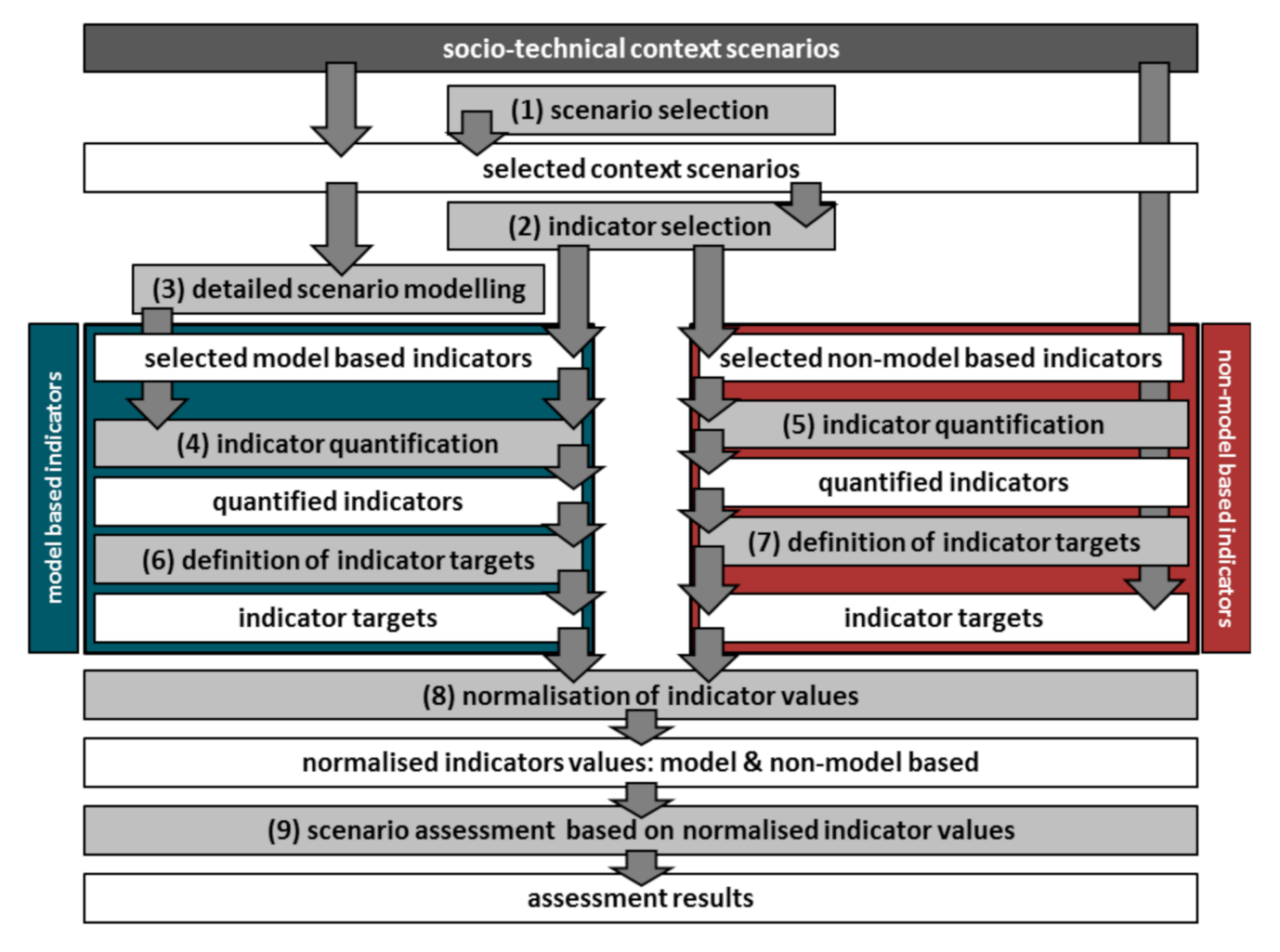
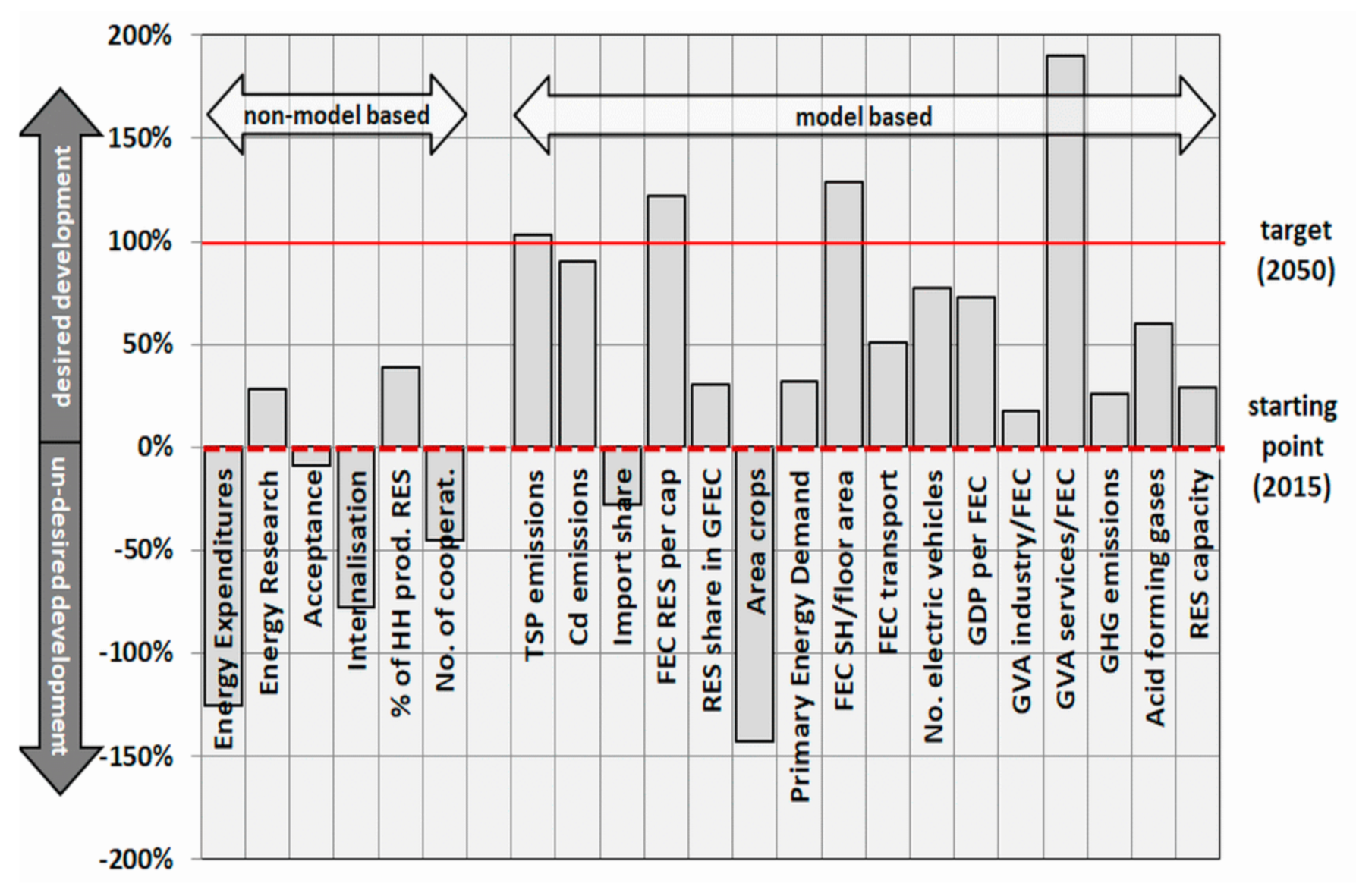
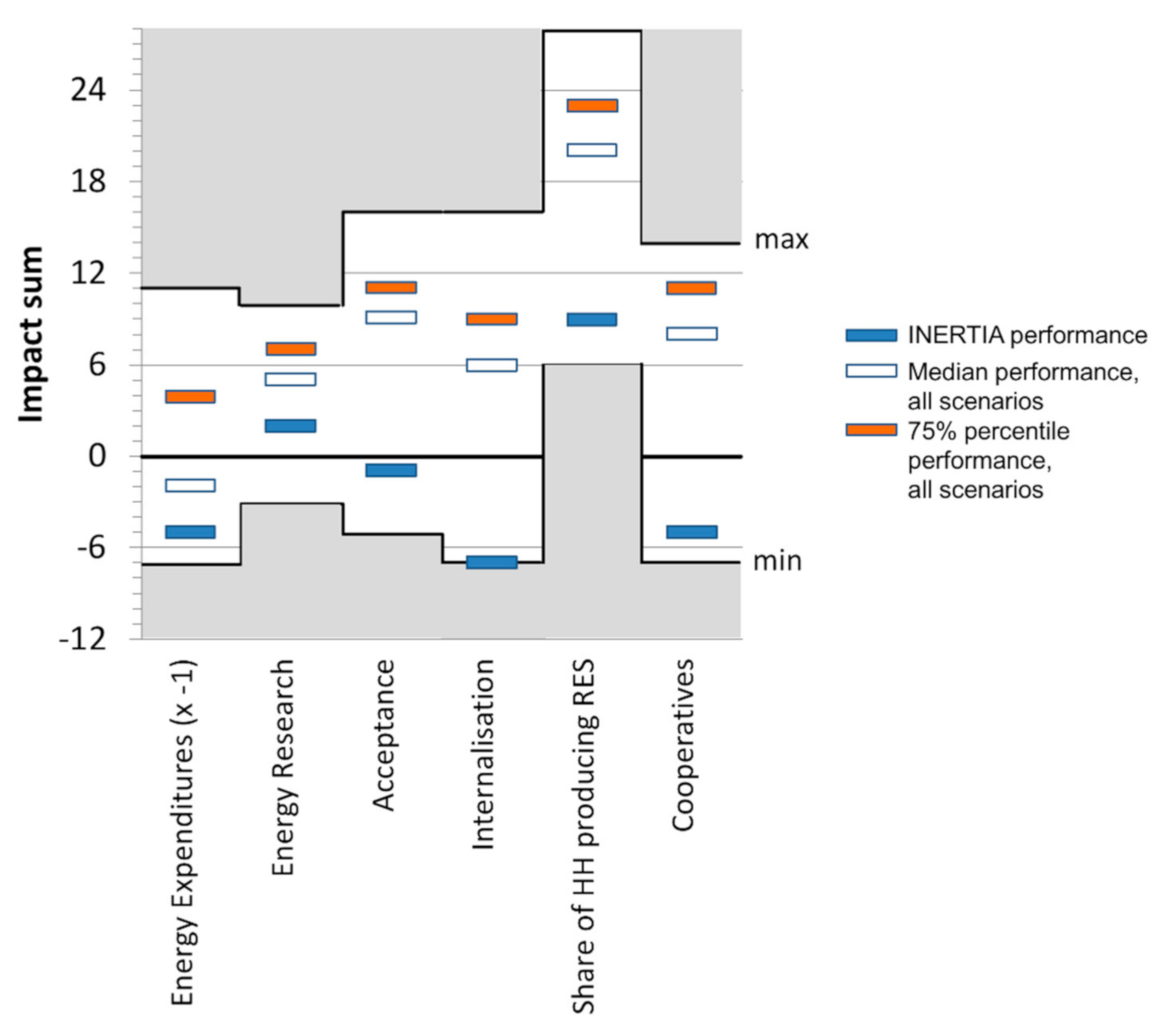
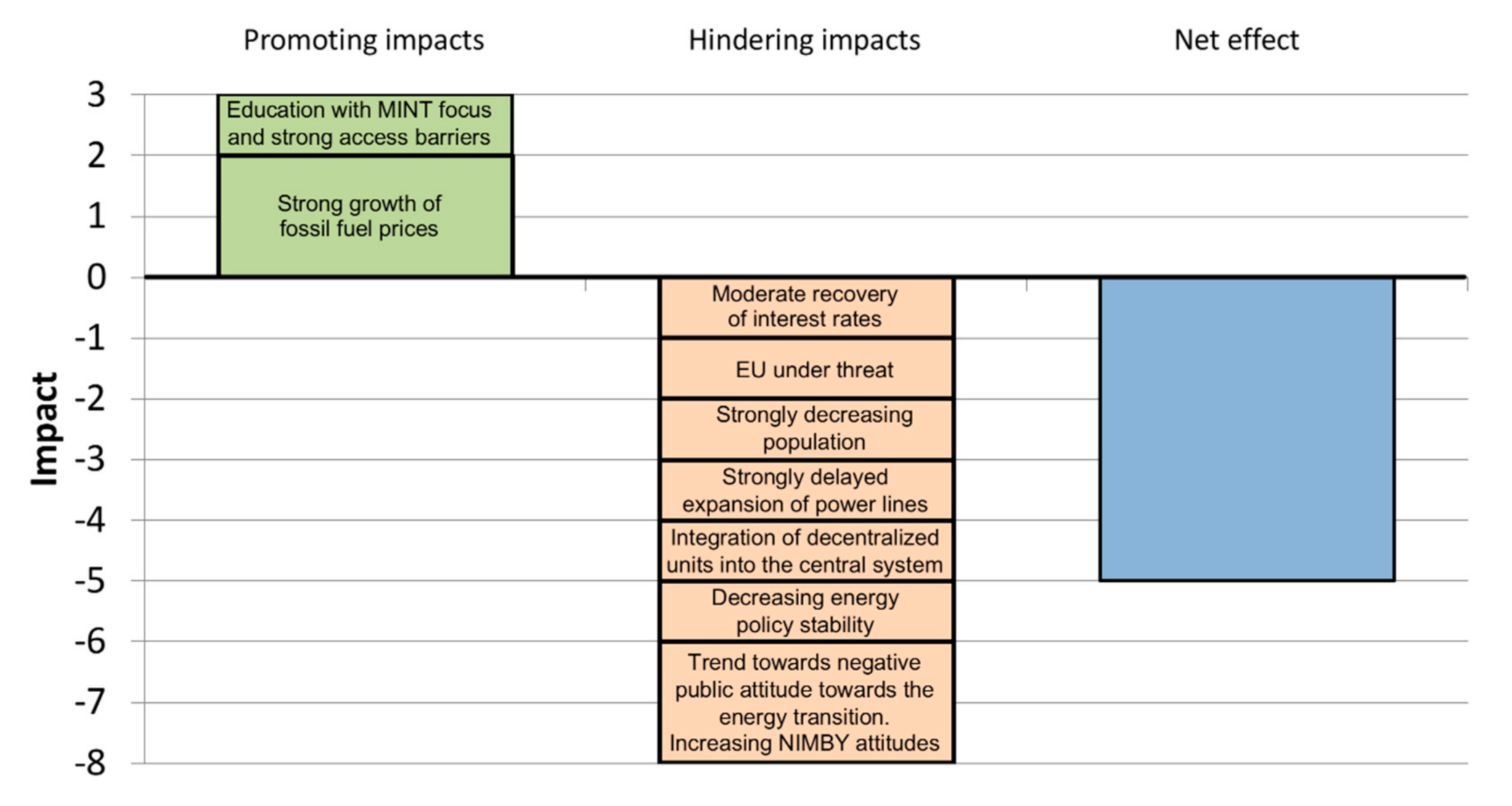
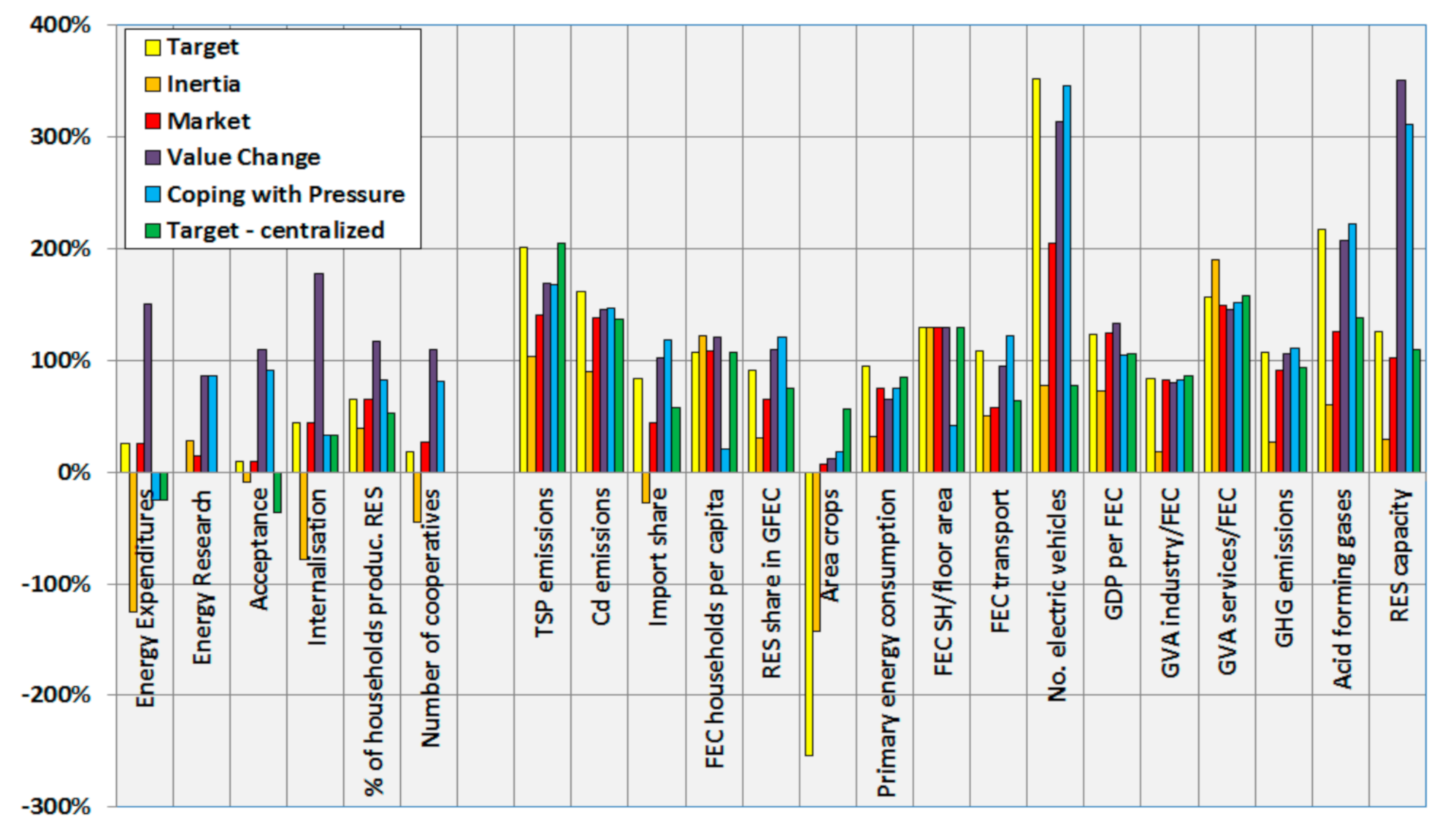
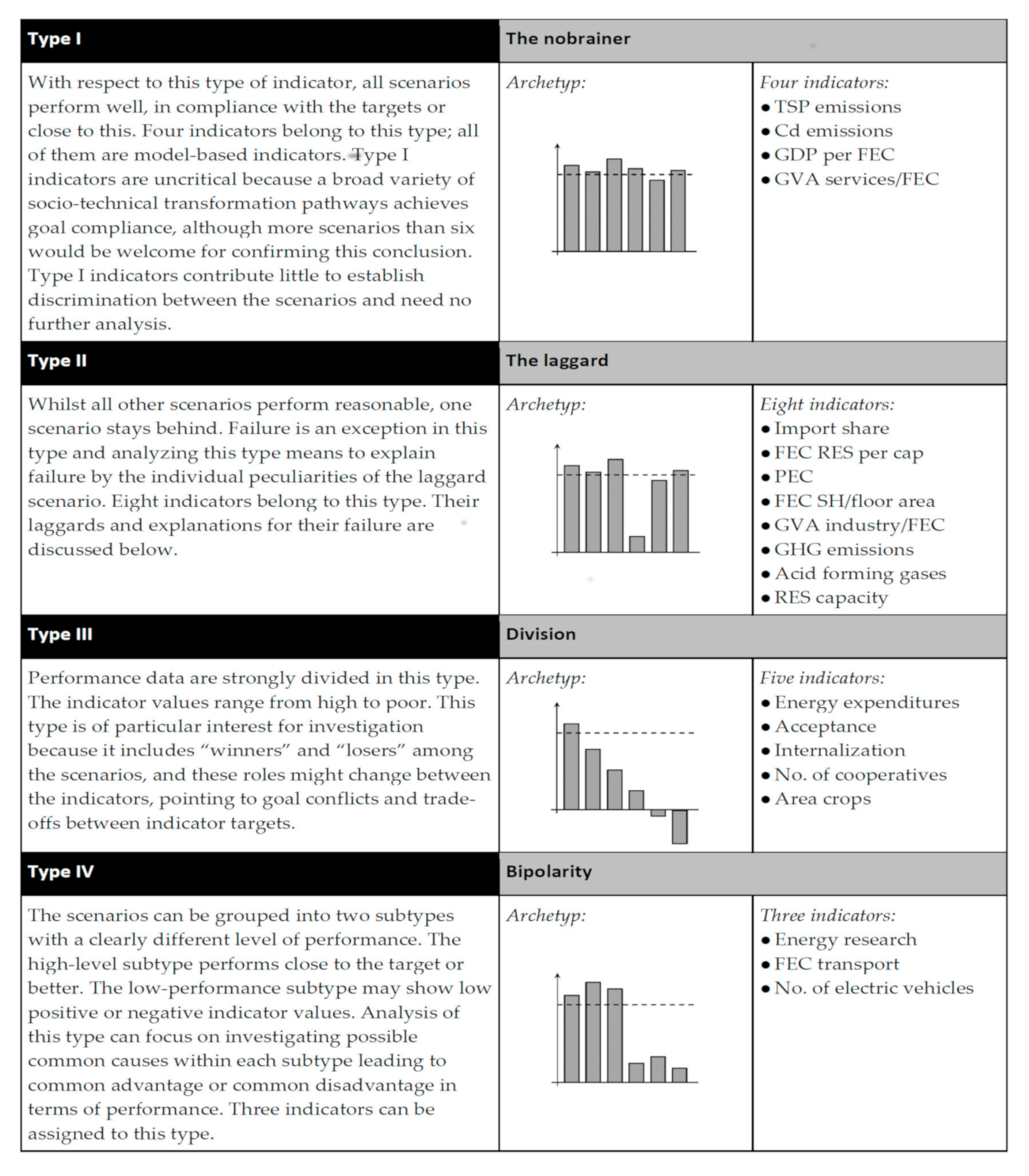
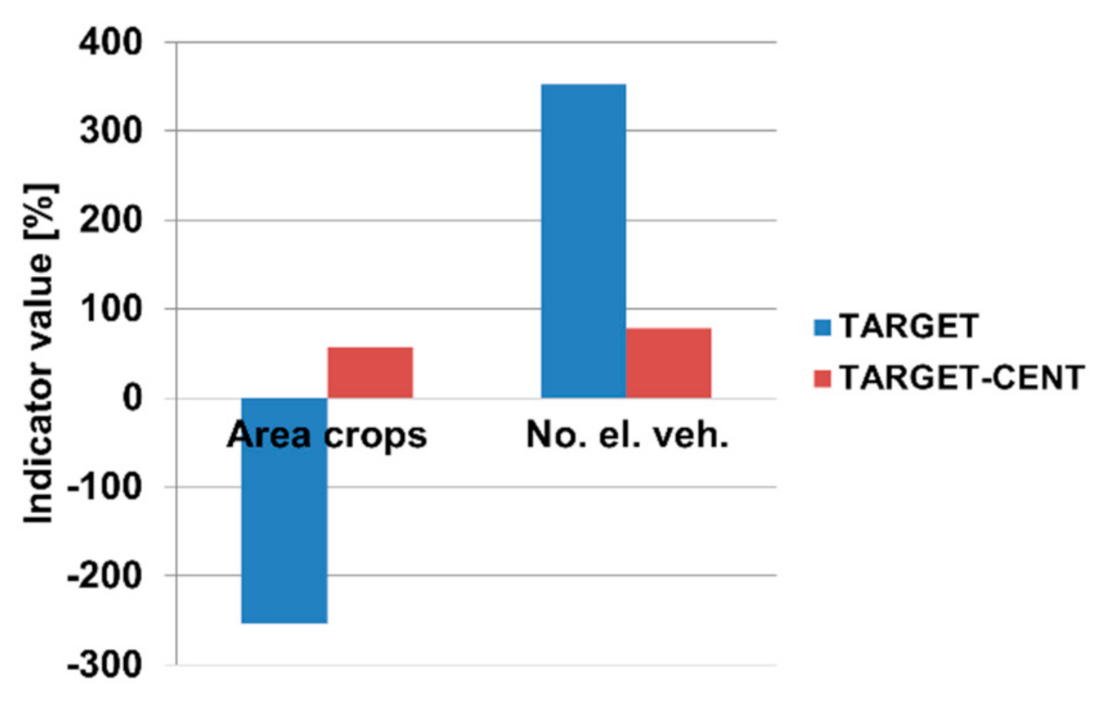

| Market | The global market paradigm drives liberalization in Germany. Materialism fosters an indifferent attitude toward the energy transition. Nevertheless, strong economic development affords the government leeway to pursue the energy transition with a steady hand and renders the materialistic population willing to accept certain burdens of the transition without considerable resistance. Renewable energy (RE) deployment achieves limited success with a main focus on the power sector. Therefore, transition targets are not met, though CO2 emission reduction outcomes are still considerable. Primary energy consumption levels are rather high due to strong economic development (higher GDP), which results in higher levels of final energy consumption in the industrial and service/commerce sectors, and in higher levels of non-energetic consumption by fossil energy carriers [35]. |
| Target | The “Target” scenario is a variation of the “Market” scenario and involves a downward feedback loop between economic growth, birth rates, and migration that results in medium economic success and a lowered population. Nevertheless, supported by reinvigorated EU integration and harmonized energy policies, prospects are sufficient for the implementation of ambitious efficiency measures and high RE shares across all sectors, resulting in the lowest level of primary energy consumption and second lowest level of GHG emissions across all six scenarios. Intensified levels of electrification and hydrogen use in the transport and heating fields increase gross electricity consumption [35]. |
| Target-Centralized | This scenario is closely related to the “Target” scenario. However, this scenario pursues the transition rather within the traditional centralized energy system leading to different technology choices, whereas the “Target” scenario develops a mixed system architecture. This difference is connected to a more negative public attitude towards the energy transition project than in “Target”, making a more decentralized system architecture challenging to achieve. Vice versa, the centralized approach, offering less opportunities to individual engagement, does little to improve the public view on the transition project. A further consequence of the negative public attitude is a rather sluggish development of new mobility structures in this scenario. |
| Value Shift | A society at ease with its European and global environment pursues the energy transition with belief and involvement. However, its post-materialistic values develop only on foundations of advanced wealth after a phase of economic prosperity. High GDP and population values burden the emissions balance in spite of successful structural and mental changes. Compared to the “Target” scenario, the “Value Shift” scenario results in only slightly higher emissions, due to the highest share of RE and the highest primary energy use of all variants. The latter results from high GDP and population growth levels increasing final energy consumption despite similar energy intensities involved. In addition, the higher share of heat pumps used in households and higher levels of hydrogen demand for industry and transport cause this scenario to involve the highest levels of power demand. As the “Value Shift” scenario uses more geothermal power (with rather low efficiency), this also increases primary energy demand. The strong deployment of renewable energies is made possible by a strong acceptance of new technologies, a positive public attitude, high levels of political stability, and coordinated and multi-scale governance, especially towards the use of wind power, photovoltaic installations, and grid expansion. The “Value Shift” scenario benefits as well from successful global policy reforms and from intensified European integration and cooperation and therefore from similar developments regarding RE deployment and infrastructure expansion [35]. |
| Inertia | The “Inertia” scenario is characterized by a quite different societal storyline. Severe international conflicts, global fragmentation, and high fossil fuel prices should motivate society to transform. However, this also narrows political margins of the government and political, regulative, and societal uncertainties, while unsettled public opinion averse to experimentation renders it impossible to take up the challenge. Weak economic development and limited innovative ability limit RE expansion and improvements in industrial efficiency. However, weak economic development also results in relatively low levels of energy demand. Nonetheless, the “Inertia” scenario shows the highest CO2 emissions for 2050 relative to the other scenarios as a result of relative weak RE expansion observed in the power and heat sectors [35]. |
| Coping with Pressure | Again, this scenario describes a society under pressure from political and economic developments (EU disintegration and high fuel prices). However, pressure is reduced compared to “Inertia” (less global crises), and Germany manages to sustain a reasonable economic growth. This prepares the ground for the population to meet the challenges of the energy transition with a positive attitude, allowing more transformative measures than possible in the “Inertia” scenario. By preference, this scenario rather shows inclination to economic and societal liberalisation. However, the urgency of rapid transformation also requires regulative approaches in some cases. The CO2 reduction in this scenario is strong, though not target complying. |
| Impacts on indicator “Acceptance of Renewable Energies in the neighbourhood” Descriptor ”Policy stability in the energy sector“ and scoring by experts |
| Variant 1: Reduced policy stability (scoring: “−1“) |
| Variant 2: Constant policy stability (scoring: “0“) |
| Variant 3: Higher policy stability (scoring: “1“) |
| Arguments in the expert discussions: |
| Reduced policy stability (Var. 1) has a negative impact on acceptance: Declining confidence in the competence of policymakers, for example in their risk/benefit assessments of renewable energies, and thus in the technological solutions they propose. However, the impact is unlikely to be too pronounced, so a “−1” is assigned here. Correspondingly, a “1” is assigned for higher policy stability (Var. 3). If policy stability remains constant (Var. 2), nothing will change compared to the status-quo, and a “0” must therefore be assigned here. |
| Descriptor ”Attitude of the population towards the transformation of the energy system“ |
| Variant 1: Trend towards a positive attitude (scoring “3“) |
| Variant 2: No trend recognizable (scoring “0”) |
| Variant 3: Trend towards a negative attitude (scoring “−2“) |
| Expert arguments: |
| Variant 1: Strong “Not in my backyard” (NIMBY) behaviour will not occur, as it is considered socially unacceptable with regard to the transformation of the energy system. Therefore, acceptance increases. However, since there are currently even greater reservations in parts of the population, a positive attitude gives a major boost to acceptance. Therefore, a “3” is assigned here. |
| Variant 2: The population’s attitude towards the transformation of the energy system is positive, but there is no clear commitment to sharing its negative implications. Positive and negative narratives on the transformation of the energy system compete with each other, and no single direction is prevailing as a general picture. Therefore, a “0” is assigned. |
| Variant 3: Although the energy system transformation is still advocated in principle, local or regional implications are largely rejected. Negative narratives on the transformation of the energy system, experiences and fears associated with the transformation of the energy system perceived as negative, push the population’s attitude towards the transformation in a generally skeptical direction. People react to infrastructural measures with strong NIMBY tendencies. This is why acceptance is diminishing. Due to the fact that in principle the energy system transformation is still supported, “only” a “−2” is assigned for this case. |
| Descriptor | Variant 1 | Variant 2 | Variant 3 | Variant 4 | Impact on Indicator |
|---|---|---|---|---|---|
| Scenario “INERTIA” | “Acceptance” | ||||
| global development in general | 0 | 1 | 2 | 2 | 2 |
| global fossil price pathway ($/bbl oil) | 0 | 1 | 2 | - | 2 |
| global interest rate trend (%) | 0 | 0 | 0 | - | 0 |
| EU integration | 0 | 0 | 0 | - | 0 |
| population in 2050 (millions) | 0 | 0 | 0 | - | 0 |
| GDP growth (% per year) | 0 | 0 | 0 | - | 0 |
| employment market development | 0 | 0 | 0 | - | 0 |
| tertiarisation of the economy | 0 | 0 | - | - | 0 |
| innovative ability of the economy | 0 | 0 | 1 | - | 0 |
| transnational flows of trade | 0 | 0 | 0 | 0 | 0 |
| international integration of electricity grids | 1 | 0 | 0 | - | 1 |
| development of infrastructures (power transmission/distribution grids) | 0 | 0 | 0 | - | 0 |
| expansion of renewable energies in the electricity sector | 0 | 0 | 1 | - | 0 |
| trends central/decentralised electricity generation and storage | 0 | 0 | 1 | - | 0 |
| regulation electricity market | 0 | 0 | 0 | - | 0 |
| policy stability in the energy field | −1 | 0 | 1 | - | −1 |
| governance in the energy field | 0 | 0 | 0 | - | 0 |
| governance of infrastructure expansion | 0 | 0 | - | - | 0 |
| planning legislation/public infrastructure planning | 0 | 0 | 0 | 0 | 0 |
| governmental targets of organisation | −1 | 1 | −1 | 0 | −1 |
| welfare state development | 0 | 0 | 0 | - | 0 |
| income distribution | 0 | 0 | 0 | 0 | 0 |
| technology acceptance (energy technologies) | −2 | 0 | 1 | 3 | −2 |
| individual energy consuming behaviour | 0 | 0 | 0 | 0 | 0 |
| educational development | 1 | 0 | −1 | - | 0 |
| public attitude towards the energy transition/NIMBY | 3 | 0 | −2 | - | −2 |
| value orientation and objectives in economic development | 0 | 2 | 0 | 1 | 0 |
| media discourse | 0 | 0 | 0 | - | 0 |
| reduction energy demand—household appliance | 0 | 0 | - | - | 0 |
| reduction energy demand—PC electric vehicles | 0 | 0 | 0 | - | 0 |
| reduction energy demand—PC engines | 0 | 0 | - | - | 0 |
| renovation rate/depth—buildings (private) | 0 | 0 | 0 | - | 0 |
| reduction energy demand—industry | 0 | 0 | - | - | 0 |
| reduction energy demand—commercial sector | 0 | 0 | 0 | - | 0 |
| expansion district heating | 0 | 0 | - | - | 0 |
| investments new vehicle concepts and infrastructures | 0 | 0 | 0 | - | 0 |
| living trends (m2 space per head) | 0 | 0 | 0 | - | 0 |
| expansion of renewable energies for heating | 0 | 0 | 1 | - | 0 |
| rebound effects individual energy demand | 0 | 0 | 0 | - | 0 |
| Impact sum: | −1 | ||||
| Scenario INERTIA | Absolute | Relative (Against Median) |
|---|---|---|
| Strengths | Energy research Share of HH producing RES | none (best indicator: Energy research) |
| Weaknesses | Energy expenditures Internalization Cooperatives | Acceptance Internalization Share of HH producing RES Cooperatives |
| Indicator | FEC RES Per Cap | PEC | FEC SH/Floor Area | GVA Industry/FEC | GHG Emissions | Acid Forming Gases | RES Capacity |
|---|---|---|---|---|---|---|---|
| Laggard | COPING WITH PRESSURE | INERTIA | COPING WITH PRESSURE | INERTIA | INERTIA | INERTIA | INERTIA |
Publisher’s Note: MDPI stays neutral with regard to jurisdictional claims in published maps and institutional affiliations. |
© 2021 by the authors. Licensee MDPI, Basel, Switzerland. This article is an open access article distributed under the terms and conditions of the Creative Commons Attribution (CC BY) license (http://creativecommons.org/licenses/by/4.0/).
Share and Cite
Kopfmüller, J.; Weimer-Jehle, W.; Naegler, T.; Buchgeister, J.; Bräutigam, K.-R.; Stelzer, V. Integrative Scenario Assessment as a Tool to Support Decisions in Energy Transition. Energies 2021, 14, 1580. https://doi.org/10.3390/en14061580
Kopfmüller J, Weimer-Jehle W, Naegler T, Buchgeister J, Bräutigam K-R, Stelzer V. Integrative Scenario Assessment as a Tool to Support Decisions in Energy Transition. Energies. 2021; 14(6):1580. https://doi.org/10.3390/en14061580
Chicago/Turabian StyleKopfmüller, Jürgen, Wolfgang Weimer-Jehle, Tobias Naegler, Jens Buchgeister, Klaus-Rainer Bräutigam, and Volker Stelzer. 2021. "Integrative Scenario Assessment as a Tool to Support Decisions in Energy Transition" Energies 14, no. 6: 1580. https://doi.org/10.3390/en14061580
APA StyleKopfmüller, J., Weimer-Jehle, W., Naegler, T., Buchgeister, J., Bräutigam, K.-R., & Stelzer, V. (2021). Integrative Scenario Assessment as a Tool to Support Decisions in Energy Transition. Energies, 14(6), 1580. https://doi.org/10.3390/en14061580







